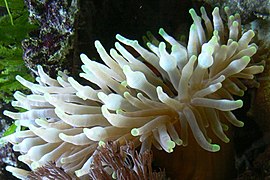Bubble-tip anemone
| Bubble-tip anemone | |
|---|---|

| |
| A colony of Entacmaea quadricolor. Young individuals may have about 20 tentacles, with numbers increasing during their lifetime.[1] | |
| Scientific classification | |
| Domain: | Eukaryota |
| Kingdom: | Animalia |
| Phylum: | Cnidaria |
| Class: | Hexacorallia |
| Order: | Actiniaria |
| Family: | Actiniidae |
| Genus: | Entacmaea |
| Species: | E. quadricolor
|
| Binomial name | |
| Entacmaea quadricolor (Leuckart in Rüppell & Leuckart, 1828)
| |
| Synonyms | |
|
List
| |
Bubble-tip anemone (Entacmaea quadricolor) is a
Distribution
Entacmaea quadricolor is widespread throughout the
A characteristic of E. quadricolor is its ability to maintain a
Nutrients are generally obtained by
In the wild, E. quadricolor are found in two locations. Large adult specimens, with tentacles that are more streaming or stringy, are often found in deeper waters with more dimly lit conditions. These specimens are often solitary, while smaller, younger specimens are often located in groups or colonies nearer to the surface, in bright sunlight. These specimens tend to show the bulbous tips on their tentacles that are characteristic of E. quadricolor. The tips of the anemones will have their characteristic bulbs based on several parameters, including; flow, light, bacterial count, color, and if its hosting. When they are placed in home aquariums, medium flow and medium lighting will be sufficient if your tank is old enough to captivate anemones.[citation needed]
Symbionts

E. quadricolor is found within the range of most anemonefish and is highly generalist, hosting 14 different species, around half the species of anemonefish.[4] It is thought the primary reason it does not host other species is competition, with other factors being habitat preferences or host-fish biochemical signalling.[4] The anemone fish hosted by E. quadricolor are: [3]
- Amphiprion akindynos (Barrier reef anemonefish)
- A. allardi(Allard's anemonefish)
- A. barberi (Barber's anemonefish) [5]
- A. bicinctus(Two-band anemonefish)
- A. chrysopterus(Orange-fin anemonefish)
- A. clarkii(Clark's anemonefish)
- A. ephippium(Red Saddleback anemonefish)
- A. frenatus(Tomato anemonefish)
- A. mccullochi (Whitesnout anemonefish)
- A. melanopus(Red & Black anemonefish) (primarily clustered form)
- A. omanensis (Oman anemonefish)
- A. rubrocinctus(Australian anemonefish)
- A. tricinctus(Three-band anemonefish)
- Premnas biaculeatus(Maroon anemonefish) (only solitary form)
E. quadricolor also associates with juvenile
Reproduction
Sexual reproduction
E. quadricolor exhibits a variety of reproductive strategies. The most common strategy would be a form of sexual reproduction called broadcast spawning. This is considered the main form of reproduction and occurs at the start of the year between January and April for those in eastern Australian waters.[7] During these times, E. quadricolor will release its gametes into the water column and form free-swimming planula larvae.[8] These larvae of E. quadricolor have been observed to survive up to 59 days in the water column, with peak settlement occurring around 10 days. This time of suspension allows for greater dispersal and increases genetic diversity for the species. Once the larvae settle, they will then begin to further develop and start the cycle once more.
Asexual reproduction
E. quadricolor can also reproduce asexually. For most anemone species, asexual reproduction may occur by pedal laceration, longitudinal fission, or transverse fission. E. quadricolor will occasional reproduce asexually using longitudinal fission, but this is on rare occasions. This form of reproduction allows for quick reproduction of successful genotypes but will also lead to genetic isolation and reduced dispersal as individuals are likely to attach to the first hard surface they encounter.[8]
Aquaculture
In aquariums, E. quadricolor will reproduce asexually or sexually when in proper care with supplemented minerals such as iodine and other trace elements, usually purchased as an enrichment cocktail by most home aquarists. E. quadricolor is commonly kept in marine aquariums and comes in variety of colors, green and rose being the most common. Without adequate lighting, the anemone will expel its photosynthetic symbiotic zooxanthellae, a process commonly known as "bleaching" which will progressively result in its death. White or excessively translucent specimens are likely in various phases of bleaching and should not be purchased.
Anemones are not easy to keep, and require a knowledgeable aquarist. The aquarium must be at least six months old and stable to receive the anemone. The bigger the tank, the easier it will be to keep a healthy anemone.[9]
-
A group of individuals
-
Rose
-
Green tipped
-
Bleached (unhealthy)
Conservation and threats
E quadricolor is not currently listed on the
References
- S2CID 84556092.
- ^ Daly, M. & Fautin, D. (2014). "World List of Actiniaria. Entacmaea quadricolor Leuckart in Rüppell & Leuckart, 1828". WoRMS. World Register of Marine Species. Retrieved 11 March 2019.
- ^ ISBN 9780730983651. Archived from the originalon 14 April 2015.
- ^ PMID 17476781.
- ^ Allen, G.; Drew, J. & Kaufman, L. (2008). "Amphiprion barberi, a new species of anemonefish (Pomacentridae) from Fiji, Tonga, and Samoa". Aqua, International Journal of Ichthyology. 14: 105.
- JSTOR 24855576.
- S2CID 55334556.
- ^ ISSN 1424-2818.
- ^ "Bubble Tip Anemone (Entacmaea quadricolor) Care, Tank Setup, Host & Reproduction | The Aquarium Club". theaquarium.club. Retrieved 2018-08-30.
- S2CID 233578966.
External links
- Entacmaea quadricolor in Encyclopedia of Life
- Wiedenmann, J.; Schenk, A.; Rocker, C.; Girod, A.; Spindler, K.-D.; Nienhaus, G. U. (2002). "A far-red fluorescent protein with fast maturation and reduced oligomerization tendency from Entacmaea quadricolor (Anthozoa, Actinaria)". Proceedings of the National Academy of Sciences. 99 (18): 11646–11651. PMID 12185250.




